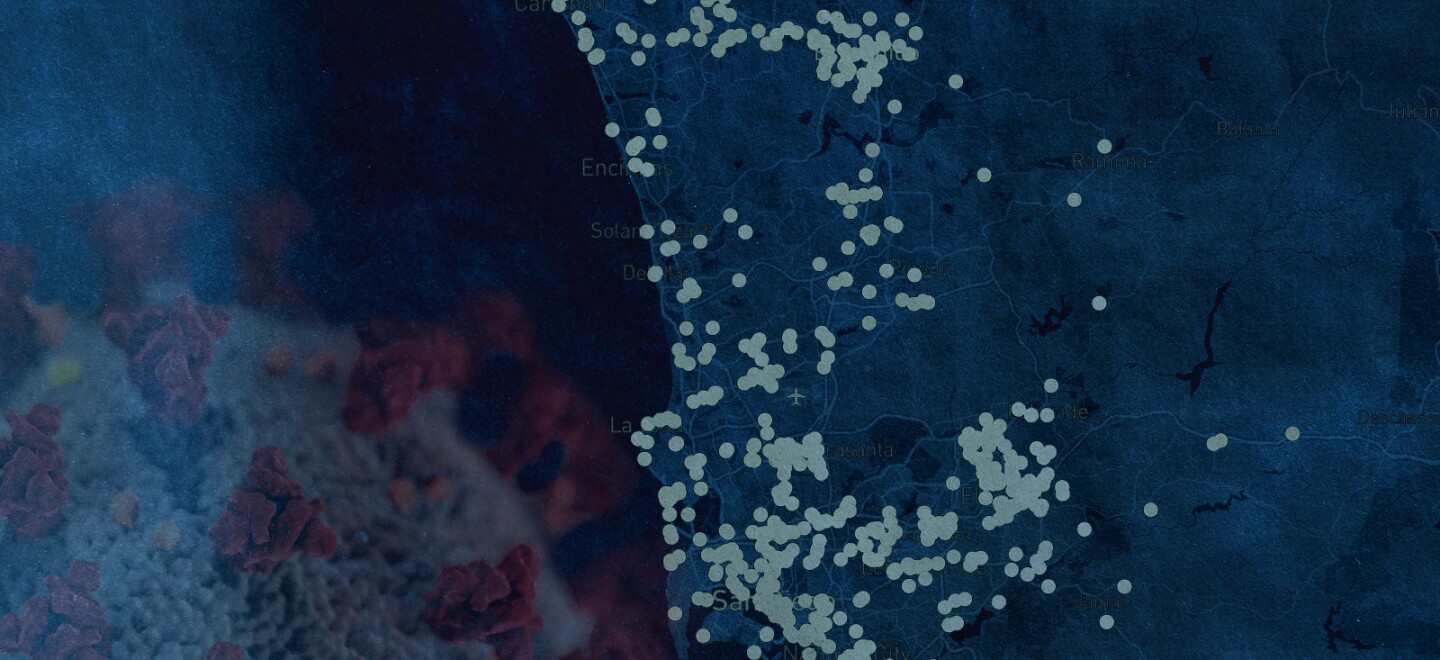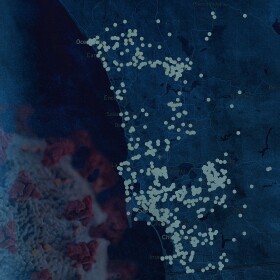This is part one in a three-part series. Click here to read part two and part three.
Community outbreaks of COVID-19 have touched every corner of San Diego County and all types of establishments over the past nine months, but they are most prevalent in big box stores, restaurants and group living situations like nursing homes and jails, according to county outbreak records obtained exclusively by KPBS.
If you’ve gone out at all since the pandemic first struck, you quite likely walked into a place where an outbreak occurred, according to the KPBS analysis of 1,006 outbreak records dating from March through the end of November. For example:
– At least 208 outbreaks have occurred in restaurants, with popular chains like Olive Garden, Cheesecake Factory, Denny’s and The Broken Yolk Cafe having multiple outbreaks each.
– At least 205 outbreaks have occurred in businesses with services that run the gamut from car repair to pet care to banking and shipping.
– At least 125 outbreaks have occurred in large retailers and grocery stores like Walmart, Costco, Target, Home Depot and Trader Joe’s.
How to: Use this interactive map to search for outbreak locations by place category, address, ZIP Code, date investigation was opened or outbreak numbers. Zoom in and click the dots on the map to see the name of a location, address and how many outbreaks have occurred there. For clarification, the outbreaks column displays an outbreak out of the total number of outbreaks at the same location.
However, just because you visited a place that had an outbreak doesn’t necessarily mean you were exposed to the virus and doesn't mean you can catch COVID-19 by going there now.
An outbreak means three or more people with COVID-19, who aren't close contacts, were in that place over the same 14-day period. So, those people may have never crossed paths—they could have even been there on different days. And it's possible none of them caught the virus at the outbreak location. Being the site of an outbreak doesn't necessarily mean the businesses had unsafe practices.
The records reviewed by KPBS include all outbreak locations during the first nine months of the pandemic, but only specific case counts for the month of November. The November records show that most of the outbreaks are small—fewer than 10 cases—and they don’t reveal whether employees or patrons were infected.
But the overall records do show you're far more likely to be exposed to an outbreak based on your living circumstances and/or your behavior. For example:
– At least 252 outbreaks occurred in nursing homes, jails, rehab facilities and shelters.
– At least 136 outbreaks occurred in five lower income ZIP codes in East and South County, where many essential workers live.
– At least 30 outbreaks have occurred at religious organizations since March. In November, outbreaks at houses of worship had a combined case count of at least 187, almost half of those coming from Awaken Church.
– At least 86 outbreaks happened in the Pacific Beach and Gaslamp ZIP codes, two of the county’s biggest party spots.
– Seven casinos in the county have had outbreaks with a combined case count of more than 638.
This is the first time the public has seen this much outbreak data with this level of specificity for San Diego County. Since the onset of the pandemic, county officials have kept outbreak locations secret, instead only listing outbreaks by category such as "bar/restaurant" or "business."
The records obtained by KPBS represent a snapshot in time of an ever-changing dataset. Cases continue to increase at existing outbreak locations and new outbreaks pop up regularly, especially as the San Diego region is in the midst of a huge surge of COVID-19 cases.
County officials refused to comment for this story. But Greg Cox, the chairman of the county Board of Supervisors, sent a letter last week to KPBS General Manager Tom Karlo, urging him stop the publication of this story.
In the past officials have said it is not important for the public to know detailed information about community outbreaks because they only account for about 4% of all COVID-19 cases in the county. The KPBS analysis of November outbreaks shows they accounted for about 8% of all cases during the month. Officials also argue that businesses and other organizations would not report outbreaks to the county if they were made public.
News organizations and other public interest groups have opposed the county, arguing that public health and the public interest is best served when people have the public health records of outbreak locations at their disposal.
In August, Voice of San Diego, KPBS and The San Diego Union-Tribune sued the county under the California Public Records Act for all of its outbreak location records. The news organizations have pointed out that other jurisdictions, including Los Angeles County and the state of Oregon, make their outbreak information public.
During an October hearing in the case, county lawyer John Cooley said the county’s contact tracing program "would break down" if more detailed outbreak information were made public.
"Without voluntary disclosures, the county can't do the necessary contact tracing," Cooley said. "The county depends on voluntary disclosures to combat the pandemic here. There's no way for the county to find out if a mom and pop shop on El Cajon Boulevard had an outbreak if they don't disclose it."
However, businesses and other organizations would be breaking the law if they failed to report their outbreaks to the county.
Last month, a Superior Court judge ruled in favor of the county. KPBS and the other news organizations are appealing that decision.
How are outbreaks found?
A description on the county’s website details how outbreaks are identified. It starts with contact tracing. When someone tests positive for COVID-19, they get a call from a case investigator.
"We interview all cases about their activities during the two weeks prior to their illness onset," the county's website says. "They may mention places they worked, shopped, visited, went to church, attended a gathering, etc."
If three people mention the same location within a 14 day period, it's labeled as an outbreak.
But Rebecca Fielding-Miller, an epidemiologist at UC San Diego, said given the current case surge, it would be extremely difficult for contact tracers to do all the detailed interviews required to accurately pinpoint the risk someone has of catching the virus in a specific location.
"If it’s nine staff members all working in the kitchen together and you have nine people test positive within a 14 day window, my initial assumption would be that those are connected," she said. "But if nine people report they happened to be in a Walmart in Chula Vista within a 14-day window because they were grocery shopping, you’d have to narrow it down to a specific window, say they were all there between 2 and 5 pm on a Wednesday. And you can’t do that when you have 2,000 cases a day."
Historically it’s made sense to trace outbreaks for sexually transmitted diseases, and for very rare diseases like measles, Fielding-Miller said. But with COVID-19, which is both highly contagious and widespread, tracing outbreaks isn’t necessarily practical.
"It's like the wildfire analogy, where it can tell you where there are flare ups, which is useful when everything is not on fire," she said. "But when everything is on fire, it’s not as useful."
Fielding-Miller also said considering the context in the numbers obtained by KPBS is important. A higher number of outbreaks at retail chains is likely partly because they have multiple locations and more people work there and visit them.
"You wouldn't say Otay Mesa Detention Center has only had one outbreak and Denny’s has had five, therefore Otay Mesa is safer," she said.
But there are also trends in the data that make sense with what else we know about COVID-19. There are multiple large outbreaks at retail centers like Walmart and Costco, and none at Whole Foods. That doesn't necessarily mean Whole Foods is safer—it could be because lower-income people, who by virtue of their living situations are more vulnerable to COVID-19, are more likely to shop at the bigger retail chains, Fielding-Miller said.
She added that it's likely the outbreaks at restaurants and grocery stores are occurring between employees, because they spend more time in close proximity, but it's impossible to know because the county does not keep separate records for employees and customers.
Workers at risk
The records obtained by KPBS show how the pandemic has evolved throughout the year in San Diego County. During the spring, nursing homes and senior care facilities accounted for more than half the county’s outbreaks. By November, even though case counts remain high in these facilities, they represented only 12% of new outbreaks for the month.
Meanwhile, 20% of the November outbreaks were in retail and grocery stores and 19% were in restaurants and bars. This means that an increasingly large number of workers are in establishments that have experienced outbreaks. Many say they are not being adequately protected.
Last month, workers at an AT&T call center in Sorrento Valley planned a walkout because they said 11 people had tested positive for COVID-19 and they didn't feel safe working there. But the employees said the county didn’t inform them of the cases. Instead, Chris Roberts, the president of the local Communication Workers of America union, said they collect and notify union members of cases.
"If we weren't diligent in discovering the outbreak, no one would have known," Roberts said.
He said if the county publicly posted information about outbreaks at businesses, it would better protect workers. The county records obtained by KPBS do show an outbreak at that location, but with three cases, not 11.
"Family members want to know," Roberts said. "People want to be able to make decisions about whether to go to work, so people can make informed decisions."
In response to questions from KPBS, an AT&T spokesman said in an emailed statement that many employees work from home, but "some teams must report to an office due to the nature of the work that they perform." Those employees receive rapid testing and follow safety protocols, he said.
Workers at Costco are "very afraid" of contracting the virus, said Jaime Vasquez, the secretary-treasurer of the Teamsters Local 542, which represents some of the region's Costco employees. The records obtained by KPBS show 132 cases tied to 16 different outbreaks since the beginning of March.
When the pandemic first hit, Costco "did a fabulous job, they limited entrance to 600 people including staff," he said. Vasquez said the stores are allowing half capacity, which can still feel packed, "especially with Christmas shopping." Vasquez argues Costco is a retail store, which he said means it should be limited to 20% of its max capacity.

Costco did not respond to a request for comment. Other big retailers, such as Walmart, Target and Home Depot, sent statements to KPBS saying they prioritized safety and have taken extra measures during the pandemic.
A spokeswoman for Target acknowledged having multiple cases among employees at some of its stores. The records obtained by KPBS show 95 cases tied to 10 outbreaks at Target stores in San Diego County.
"We’re paying these team members while they’re on leave and our thoughts are with them during this challenging time," the spokeswoman said in a statement. "After learning about positive cases, we also work quickly to deep clean and sanitize the store, which is the recommendation of public health experts and is in addition to the frequent disinfecting and cleaning we do at stores throughout each day. We notify the entire store team and provide them with the appropriate CDC guidance."

At Walmart, as well as at other big box retailers, store policy is to do temperature checks and health screenings on employees, have plexiglass barriers at checkout and limit store capacities to 20%.
"During this challenging time we’re working to balance health and safety concerns while still meeting the needs and expectations of our customers and associates," a Walmart spokeswoman said in a statement.
Devon Hannagan, who works as a supervisor at Vons on Balboa Avenue, said he would like more information on outbreaks at businesses. "Every man and woman who works for a company should be able to evaluate their own risk and come up with an idea of what's too much," he said.
San Diego County's health order says when an employee tests positive for COVID-19, the employer must notify "any employees, and contractors (who regularly work at the workplace), who may have been exposed."
Next month, the state will begin posting some data about employees who've been exposed, but without naming specific locations.
Unequal treatment
Certain businesses, including gyms and salons, have faced some of the most severe restrictions from the stay-at-home order while having relatively few outbreaks. Gyms had 14 outbreaks total since March, and salons and barber shops only had 10, according to the records obtained by KPBS.
Bryan Welch, general manager at Point Loma Sports Club, said he wishes the county could close businesses based on business practices and safety, not categories.
"I wish I could wave a magic wand to say each business gets evaluated on its merits, but then you would have to have 10,000 people working for the county going out to each business," he said.
The number of outbreaks at restaurants surged to 46 in July after dining was reopened, including indoors. But then the number fell to 18 for August after dining was restricted to outdoors. The number of restaurant outbreaks gradually increased through the fall, and rose to 60 in November, according to the numbers KPBS obtained.
Last week, a San Diego Superior Court Judge ruled that businesses "with restaurant service" could remain open. County officials at first said they would "suspend enforcement activities against restaurants and live entertainment establishments," prompting many restaurants to reopen, including for indoor dining. By Friday, an appeals court judge stayed the ruling, meaning restaurants had to close again, at least temporarily.
In addition, some businesses have refused to close or modify their operations to match county orders and have been served with cease and desist orders. Some businesses with more than one outbreak also have received cease and desist or closure letters, including El Prez and King and Queen Cantina.
San Diego County has argued in the past that revealing case numbers at businesses might let people decipher who has had COVID-19 at that business, which could be a privacy issue. But El Cajon City Manager Graham Mitchell called that argument "a cop out."
"I had it, there's no stigma around it, we don’t shy away from telling people we had the flu or chickenpox," he said.
He said he thinks the county has pointed out categories with outbreaks to defend its decisions about what to close.
"That data point serves them because they have to defend the closure of bars and restaurants," he said. "But they can’t play it both ways, can’t use the numbers and then not reveal them."
Editor’s Note: Thanks to suggestions from many of you, we’ve updated this interactive to include the date the county began investigating each outbreak and more clearly show how many outbreaks have occurred at each location. If you have thoughts or suggestions, please send them to us in the comment box below.









